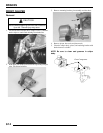
9.9
BRAKES
9
12. Install diaphragm, sight glass, cap and screws.
13. Wiggle and press down on the cap to be sure it fits evenly
and snug.
14. Torque the screw to specification .
15. Field test machine at low speed before putting into service.
Check for proper braking action and lever reserve. With
lever firmly applied, lever reserve should be no less than 1/
2”, (1.3 cm) from handlebar.
16. Check brake system for fluid leaks and inspect all hoses and
lines for wear or abrasion. Replace hose if wear or abrasion
is found.
FRONT MASTER CYLINDER
Removal
1. Clean master cylinder and reservoir assembly. Make sure
you have a clean work area to disassemble brake
components.
2. Remove master cylinder from handlebars.
3. While holding upright, continue to remove master cylinder.
Cover the brake line to avoid spillage when removing the
brake line banjo bolt.
Installation
1. Install master cylinder on handlebars. Torque mounting
bolts to specification. Torque the inner bolt first as
indicated in the illustration below.
= T
Master Cylinder Cover Screw Torque:
7 in.lbs. (0.79 Nm)
Sight Glass
Master Cylinder Cap
Diaphragm
Cap Screws
Cap Must be Even
Torque Inner
Bolt First
7 in.lbs. (0.79 Nm)
CAUTION
Brake fluid will damage finished surfaces.
Do not allow brake fluid to come in
contact with finished surfaces.
= T
Master Cylinder Mount Bolt Torque:
25 in. lbs. (3 Nm)
Torque Inner Bolt First
7 in.lbs. (.79 Nm)
Torque inner Bolt First
25 in.lbs. (3 Nm)


















